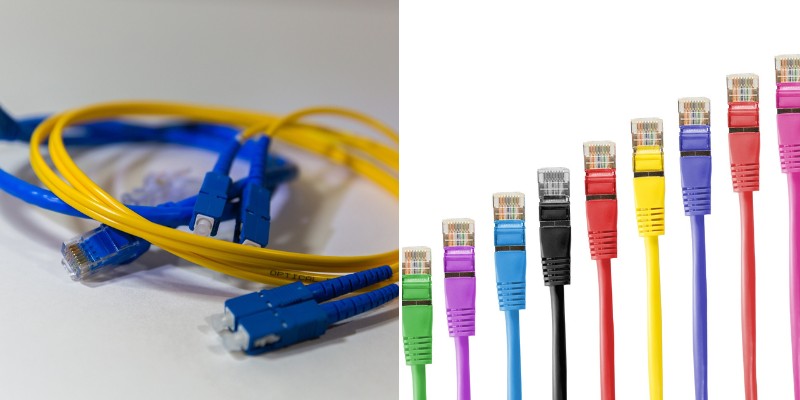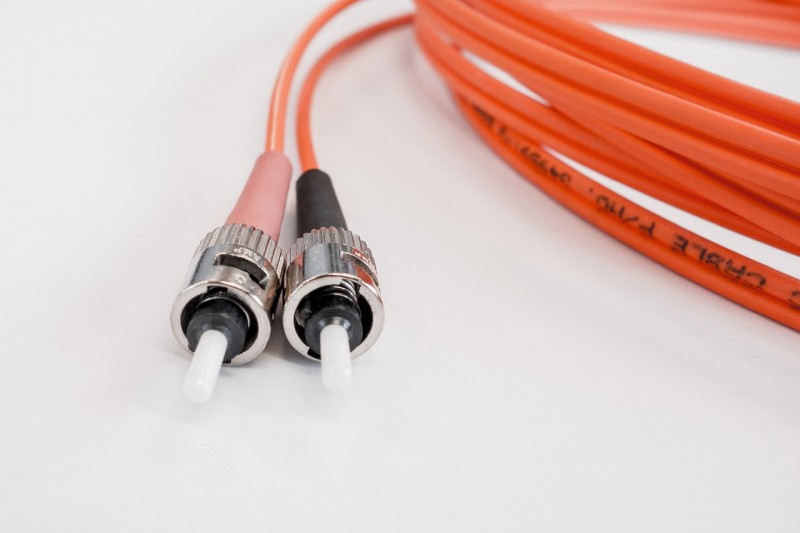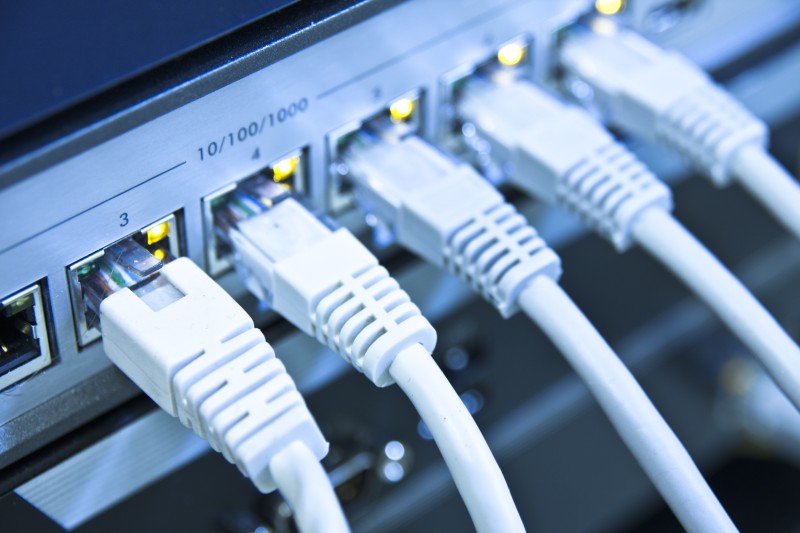Ever since the explosion in popularity of the Internet back in the late 1990s, networking technology companies have worked tirelessly to improve the infrastructure that supports it.

From the earliest token-ring networks to the latest satellite swarm technology like SpaceX’s Starlink, there have been tremendous leaps forward.
However, when it comes to Local Area Network (LAN) transport (or even in Wide Area Networks), two connectivity technologies still reign supreme. These are fiber optic and copper ethernet cabling, respectively.
They’re the two types of cabling you’ll find supporting the vast majority of networks ranging from small home LANs up to large ISP data center networks.
Both fiber optic and copper ethernet cables have unique characteristics and compelling advantages and disadvantages but they are generally used to support the same communication protocol which is the Ethernet standard (IEEE 802.3).
In this article we’ll compare fiber optic vs copper ethernet cabling, some pros/cons of each one, when to use each type etc.
Understanding Fiber Optic and Copper Ethernet Cabling
Before delving into the advantages and disadvantages of fiber optic and copper ethernet cabling, it’s important to understand what they are first.
Both are types of network cabling that enable the transfer of large amounts of data between computers or networks, usually in TCP/IP networks using the Ethernet communication protocol.
So, even if the regular copper UTP cable is most of the times called just “Ethernet” cable, you should note that the fiber optic cable is also used in Ethernet communication protocol.
Fiber Optic Cables
Fiber optic cables accomplish data communication by transmitting encoded data as beams of light.

They’re made of bundles of glass fibers that act as waveguides for the light transmitted back and forth by specialized equipment on each end.
Fiber optic network cables first appeared within the US military’s NORAD facility, where they linked critical computer systems together. They didn’t gain further traction, however, until the mid-1990s.
Copper Ethernet Cables
Ethernet cables, by comparison, contain 8 solid or stranded copper wires. Those wires operate in pairs, twisted together to prevent interference from the other pairs or external sources. They are also called UTP cables (Unshielded Twisted Pair).

With an ethernet copper cable, data gets transmitted in the form of electrical impulses.
Like fiber optic systems, devices at each end have the hardware necessary to encode and decode those signals.
Ethernet copper cabling and technology date back to 1973, when it first appeared within the Xerox corporation’s research laboratories.
For a variety of reasons—not least of which is how long they’ve existed—ethernet cables are the de-facto standard for computer networking all around the world.
About Fiber Optic Network Cabling
Today, fiber optic network cabling forms the basis for the undersea network that links the global internet together.
However, it’s also used as high bandwidth backhaul cabling within large corporate networks, as well as within the data networks of major ISPs.
You can even find it in some homes, especially those with high-end home server setups and ultra-high-speed internet service.
The Advantages of Fiber Optic Network Cabling
Fiber optic network cabling comes with some significant advantages, relative to ethernet copper cabling. The following are some of the most important among them.
Faster Speeds, Greater Bandwidth
One of the greatest advantages that fiber optic network cables come with is their amazing data transfer speeds and bandwidth capacity.
Today, you’ll find fiber optic cables operating at up to 100 Gbps, but that’s typically only found within ISP-scale networks and above.
It’s more common to see them used at speeds of 10 Gbps or even 25 Gbps and 40 Gbps which are also supported by modern Ethernet switches and routers in enterprise networking environments.
However, the current record for data transmission via a fiber optic cable stands at 1.53 petabits per second, proving that fiber optic networks still have remarkable room for improvement.
Longer Communication Distance
Another big advantage of fiber optic networking cable is that it’s capable of carrying data over very long distances without the need for repeaters.
When used as network backbones, standard fiber optic cables can stretch for up to 100 kilometers. However, there are specially-reinforced fiber optic cables that can transmit data up to 200 kilometers before needing a repeater.
The above distances are based on single-mode fiber cables. Multi-mode fiber cables cover much shorter distances as we’ll see below.
On the local network scale, however, the distances that fiber optic cables can carry data are significantly shorter.
In fiber networks operating at 1 Gbps speeds, fiber optic cables can carry data between 275 and 860 meters, depending on the type of cable in use.
At 10 Gbps speeds, that distance shrinks to a maximum of 300 meters. At 40 Gbps and 100 Gbps speeds, the maximum distance shrinks even further to 150 meters.
Immunity to Electromagnetic Interference
Perhaps the most important advantage offered by fiber optic network cables is that they’re immune to electromagnetic interference.
That’s one of the reasons they saw use at NORAD, where they offered reasonable resilience against a theoretical nuclear attack near the facility.
In ordinary usage, however, it’s a trait that makes it simple for fiber optic data cables to coexist with power cables and other types of data cables without fear of crosstalk or other types of destructive interference.
The Disadvantages of Fiber Optic Network Cabling
For all its advantages, there are a variety of reasons that fiber optic cabling hasn’t displaced copper ethernet as the dominant network cable in use today. Here are a few of the more significant disadvantages associated with fiber optic network cabling.
Higher Cost
One disadvantage that hampers the adoption of fiber optic cabling, particularly at the local network level, is the cost of the cabling itself and the hardware necessary to support it.
Over short distances, fiber optic cabling is, at best, barely cost-competitive with copper-based ethernet.
However, the switches and routers that support all-fiber connections are many times more expensive than their copper-based counterparts.
As a result, many networks reserve fiber cabling for switch-to-switch connections (e.g between switches in different floors in a building) and continue to use copper cables for switch-to-device connections.
The Fragility of the Cables
Another major disadvantage of fiber optic cables is that they’re quite fragile. Since they’re made from glass filaments, they’re easy to damage and difficult to repair once they’ve suffered damage.
Anything from applying too much force while pulling the cables through risers and walls to bending them too sharply can render a fiber optic cable useless.
Difficult to Install
The final major disadvantage of fiber optic network cabling is that it’s difficult to install. This is due in large part to the fragility of the cables discussed above.
However, it’s also due to the specialized equipment and skills installers must possess to work with it.
Terminating fiber optic cables is especially difficult, requiring a deft touch and plenty of care.
It is worth pointing out, however, that the design of fiber optic cable connectors continues to develop, with new designs coming to market that may make terminating fiber optic cables much easier in the future.
About Copper Ethernet Cabling
As the most-used type of network cabling in the world, you’ll find copper ethernet cables wherever you find computer networks.
This is the cable you use to connect your PC computer or laptop to your wired home network, your game console or smart TV to your home router etc.
That should come as no surprise since copper wiring formed the basis of the world’s telephone networks and power grids, with many of the former only going out of service within the last decade or so.
Beginning with the earliest computer networks, copper ethernet is the core cabling technology that enabled the modern Internet.
Today, most network-connected devices contain copper ethernet ports, cementing it as a global standard that’s not going away anytime soon.
The Advantages of Copper Ethernet Cabling
There are plenty of good reasons that copper ethernet cabling is so common and has reigned as the king of computer networks for 50 years. Here are some of the most important advantages of this type of cabling.
Lower Cost
Since copper ethernet cables are simple to produce and used so widely, manufacturers have driven down the cost of producing them significantly over the years.
That makes UTP cables relatively cheap to purchase in quantity. Based on that alone, it’s easy to see why almost every computer network relies on extensive UTP copper infrastructure to operate.
Durability of the Cables
Copper cables, unlike fiber optic ones, are quite durable. Solid UTP cables, which make up the bulk of ethernet infrastructures, can stand up to pulling, bending, and all kinds of other forces. They’re not indestructible, but you’d be hard-pressed to find examples of UTP cable failures due to internal breakage.
Ease of Installation
Another big advantage of copper ethernet cabling is that it’s very easy to install. It’s not dissimilar to electrical cabling, being made from similar materials, and you’ll find that installing it requires only basic tools.
It’s also simple to terminate this type of cabling, either via punch-down in a wall jack or patch panel or by adding a crimped-on RJ-45 connector.
Plus, ethernet cabling is very forgiving for installers, making failed termination all but impossible.
The Disadvantages of Copper Ethernet Cabling
Of course, some disadvantages that come with copper ethernet cabling, too. Although they’re often overlooked, here are a few of the most important disadvantages.
Slower Speeds and Less Bandwidth Capacity
Today, the vast majority of ethernet cables and equipment operate at a maximum speed of 1,000 Mbps, or 1 Gbps.
While that’s adequate for garden-variety networking, it can create some bottlenecks within demanding networking environments.
It’s even getting to the point where standard 1 Gbps ethernet can barely accommodate the needs of home networks with multiple users, given the rising popularity of media streaming and low-latency online gaming.
It’s worth pointing out that more recent iterations of ethernet cables and hardware can now transmit data at speeds up to 10 Gbps.
However, you’ll only find those speeds in large networks, and it may be some time before it filters down into consumer-grade networking equipment.
Shorter Maximum Distance
There’s a good reason that you won’t find copper ethernet cabling anywhere but within local networks.
It’s because it’s incapable of carrying data over vast distances, like some variants of fiber optic cabling can.
In normal temperature conditions that don’t vary much above or below 68 degrees Fahrenheit, an ethernet copper cable run can only work reliably at a distance up to approximately 100 meters.
Beyond that, you’d need repeaters, or the signal wouldn’t be strong enough to provide a reliable network link.
Susceptibility to Electromagnetic Interference
Copper cabling is also vulnerable to electromagnetic interference. That means external signals emanating from things like power cables and motors can disrupt data transmission via ethernet.
While modern ethernet cables have some shielding and employ mitigation measures to guard against interference, they may still have interference issues in some applications.
Comparison of Fiber vs Copper Ethernet
| Speed and Bandwidth | Cost and Installation | Immunity to Electromagnetic Interference | Durability and Fragility | |
| Fiber Optic Network Cabling | 100 Gbps Max | High, Difficult | Not Vulnerable to Electromagnetic Interference | Fragile, Limited Durability |
| Copper Network Cabling | 10 Gbps Max | Inexpensive, Easy | Vulnerable to Electromagnetic Interference | Robust, Durable |
When to use Fiber or Copper Ethernet?
Speaking generally, it’s safe to say that fiber optic cabling, as it exists today, is best used for high-bandwidth links between networks or between backbone network switches.
The cost of the cabling, installation, and required equipment is simply too high for other commonplace networking situations. It’s also a natural fit for long-distance data transmission, particularly at the ISP network size and above.
Copper Ethernet, by contrast, is the best fit for most local networking applications, except where maximum transmission distance is an issue—like on a large corporate campus.
In all other situations, and especially in residential applications, copper ethernet’s mix of low cost, ease of installation, and high speed makes it a perfect choice. Plus, its ubiquity among consumer devices makes UTP copper wire the only realistic choice for compatibility purposes.
A Word on Copper Ethernet Standards
To complete your knowledge about copper ethernet, you should know that there are a variety of standards that fall within the ethernet family.
The oldest is Category 5, or Cat5. Cat5 first appeared in 2001 and only supports a maximum throughput of 100 Mbps and a bandwidth of 100 MHz
Cat5e, by contrast, debuted in 2001 and supports speeds up to 1,000 Mbps, or 1 Gbps, also at 100 Mhz.
Category 6, or Cat6, is the next copper ethernet standard, and it made its debut in 2008. It’s capable of operating at speeds up to 10 Gbps at short distances (55 meters) at 250 Mhz. Its immediate descendent, Cat6a, operates at 500 MHz, allowing it to sustain speeds of 10 Gbps for a full 100 meters.
The next Ethernet variant, Category 7, or Cat7, operates at 600 MHz and supports speeds up to 10 Gbps. It’s also fully shielded against electromagnetic interference, which makes it ideal for challenging installation sites. There’s also another variant, called Cat 7a, which is all but identical except that it operates at 1,000 Mhz.
Lastly, the latest version of copper ethernet cabling, Category 8, operates at 2,000 MHz and supports sustained speeds of up to 40 Gbps. However, it has a maximum length of only 30 meters while operating at maximum speed.